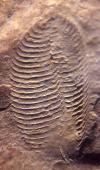 Ediacaran Organisms
Ediacaran Organisms
|
|
What are Ediacaran Organisms? The Ediacaran organisms comprise a group of Late Precambrian fossils named for the place where they were first found and described, the Ediacara Hills of Australia. Some of these fossils show similarities to invertebrates like cnidarians, echinoderms, worms, or arthropods. Others are unlike any fossil invertebrate, and their relationships to other animals are uncertain. These strange fossils may represent animals that were evolving on their own, apart from the metazoan groups we know today. Ediacaran fossils have also been found in other places around the world, including Russia, Scandinavia, England, Ireland, Newfoundland, United States, and Mexico. First known fossil occurrence: Precambrian. Last known fossil occurrence: Precambrian. Cool Ediacaran Organisms links: Search for images of Ediacaran Organisms on Google |
|

